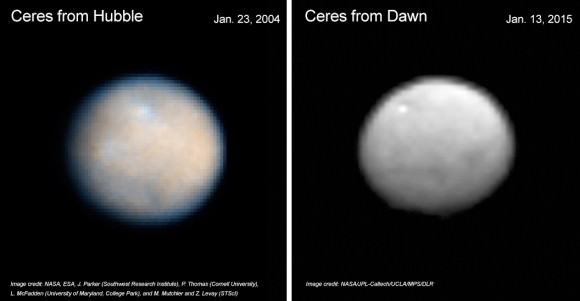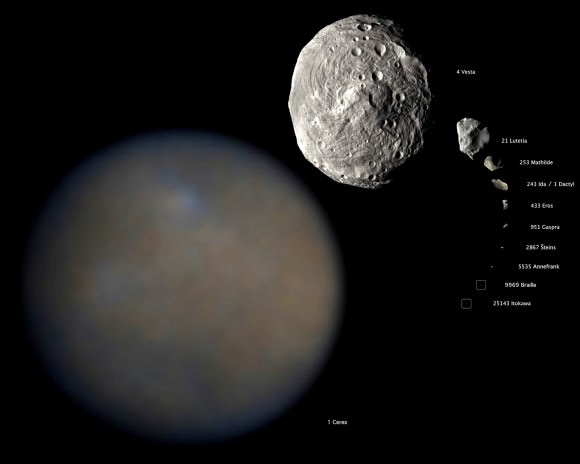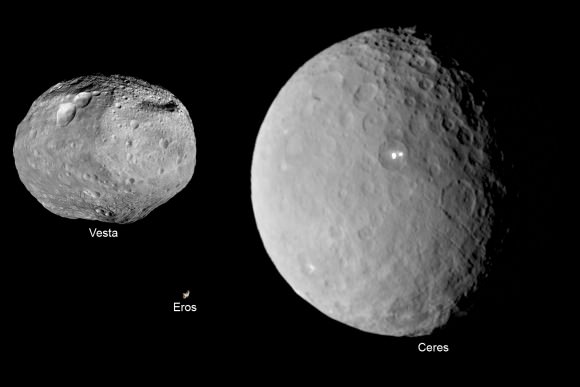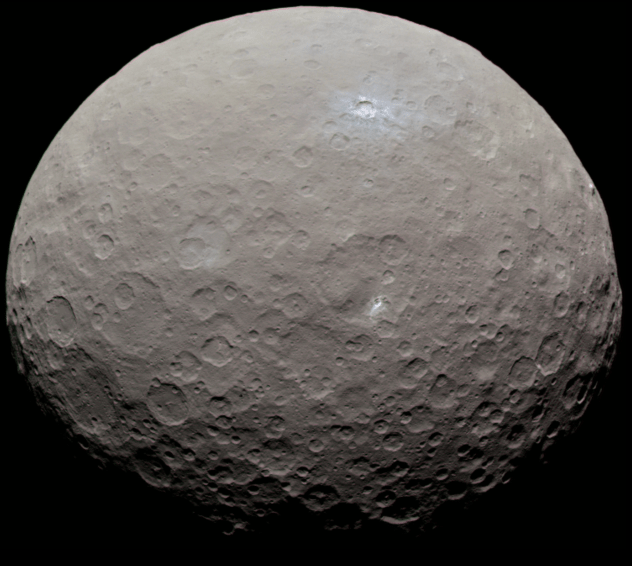The Asteroid Belt is a pretty interesting place. In addition to containing between 2.8 and 3.2 quintillion metric tons of matter, the region is also home to many minor planets. The largest of these, known as Ceres, is not only the largest minor planet in the Inner Solar System, but also the only body in this region to be designated as a “dwarf planet” by the International Astronomical Union (IAU).
Due to its size and shape, when it was first observed, Ceres was thought to be a planet. While this belief has since been revised, Ceres is alone amongst objects in the Asteroid Belt in that it is the only object massive enough to have become spherical in shape. And like most of the dwarf planets in our Solar System, its status remains controversial, and our knowledge of it limited.
Discovery and Naming:
Ceres was discovered by Giuseppe Piazzi on January 1st, 1801, while searching for zodiacal stars. However, the existence of Ceres had been predicted decades before by Johann Elert Bode, a German astronomer who speculated that there had to be a planet between Mars and Jupiter. The basis for this assumption was the now defunct Bode-Titus law, which was first proposed by Johann Daniel Titius in 1766.
This law stated that there existed a regular pattern in the semi-major axes of the orbits of known planets, the only exception of which was the large gap between Mars and Jupiter. In an attempt to resolve this, in 1800, German astronomer Franz Xaver von Zach sent requests to twenty-four experienced astronomers (dubbed the “Celestial Police”) to combine their their efforts to located this missing planet.

One of these astronomers was Giuseppe Piazzi at the Academy of Palermo, who had made the discovery shortly before his invitation to join the group had arrived. At the time of his discovery, he mistook it for a comet, but subsequent observations led him to declare that it could be something more. He officially shared his observations with friends and colleagues by April of 1801, and sent the information to von Zach to be published in September.
Unfortunately, due to its change in its apparent position, Ceres was too close to the Sun’s glare to be visible to astronomers. It would not be until the end of the year that it would be spotted again, thanks in large part to German astronomer Carl Freidrich Gauss and the predictions he made of its orbit. On December 31st, von Zach and his colleague Heinrich W.M. Olbers found Ceres near the position predicted by Gauss, and thus recovered it.
Piazzi originally suggesting naming his discovery Cerere Ferdinandea, after the Roman goddess of agriculture Ceres (Cerere in Italian) and King Ferdinand of Sicily. The name Ferdinand was dropped in other nations, but Ceres was eventually retained. Ceres was also called Hera for a short time in Germany; whereas in Greece, it is still called Demeter after the Greek equivalent of the Roman goddess Ceres.
Classification:
The classification of Ceres has changed more than once since its discovery, and remains the subject of controversy. For example, Johann Elert Bode – a contemporary of Piazzi – believed Ceres to be the “missing planet” he had proposed to exist between Mars and Jupiter. Ceres was assigned a planetary symbol, and remained listed as a planet in astronomy books and tables (along with 2 Pallas, 3 Juno, and 4 Vesta) until the mid-19th century.

As other objects were discovered in the neighborhood of Ceres, it was realized that Ceres represented the first of a new class of objects. In 1802, with the discovery of 2 Pallas, William Herschel coined the term asteroid (“star-like”) for these bodies. As the first such body to be discovered, Ceres was given the designation 1 Ceres under the modern system of minor-planet designations.
By the 1860s, the existence of a fundamental difference between asteroids such as Ceres and the major planets was widely accepted, though a precise definition of “planet” was never formulated. The 2006 debate surrounding Eris, Pluto, and what constitutes a planet led to Ceres being considered for reclassification as a planet.
The definition that was adopted on August 24th, 2006 carried the requirements that a planet have sufficient mass to assume hydrostatic equilibrium, be in orbit around a star and not be a satellite, and have cleared the neighborhood around its orbit. As it is, Ceres does not dominate its orbit, but shares it with the thousands of other asteroids, and constitutes only about a third of the mass of the Asteroid Belt. Bodies like Ceres that met some of these qualification, but not all, were instead classified as “dwarf planets”.
In addition to the controversy surrounding the use of this term, there is also the question of whether or not Ceres status as a dwarf planet means that it can no longer be considered an asteroid. The 2006 IAU decision never addressed whether Ceres is an asteroid or not. In fact, the IAU has never defined the word ‘asteroid’ at all, having preferred the term ‘minor planet’ until 2006, and the terms ‘small Solar System body’ and ‘dwarf planet’ thereafter.
Size, Mass and Orbit:
Early observations of Ceres were only able to calculate its size to within an order of magnitude. In 1802, English astronomer William Herschel underestimated its diameter as 260 km, whereas in 1811 Johann Hieronymus Schröter overestimated it as 2,613 km. Current estimates place its mean radius at 473 km, and its mass at roughly 9.39 × 1020 kg (the equivalent of 0.00015 Earths or 0.0128 Moons).

With this mass, Ceres comprises approximately a third of the estimated total mass of the asteroid belt (which is in turn approximately 4% of the mass of the Moon). The next largest objects are Vesta, Pallas and Hygiea, which have mean diameters of more than 400 km and masses of 2.6 x 1020 kg, 2.11 x 1020 kg, and 8.6 ×1019 kg respectively. The mass of Ceres is large enough to give it a nearly spherical shape, which makes it unique amongst objects and minor planets in the Asteroid Belt.
Ceres follows a slightly inclined and moderately eccentric orbit, ranging from 2.5577 AU (382.6 million km) from the Sun at perihelion and 2.9773 AU (445.4 million km) at aphelion. It has an orbital period of 1,680 Earth days (4.6 years) and takes 0.3781 Earth days (9 hours and 4 minutes) to complete a sidereal rotation.
Composition and Atmosphere:
Based on its size and density (2.16 g/cm³), Ceres is believed to be differentiated between a rocky core and an icy mantle. Based on evidence provided by the Keck telescope in 2002, the mantle is estimated to be 100 km-thick, and contains up to 200 million cubic km of water – which is more fresh water than exists on Earth. Infrared data on the surface also suggests that Ceres may have an ocean beneath its icy mantle.
If true, it is possible that this ocean could harbor microbial extraterrestrial life, similar to what has been proposed about Mars, Titan, Europa and Enceladus. It has further been hypothesized that ejecta from Ceres could have sent microbes to Earth in the past.
Other possible surface constituents include iron-rich clay minerals (cronstedtite) and carbonate minerals (dolomite and siderite), which are common minerals in carbonaceous chondrite meteorites. The surface of Ceres is relatively warm, with the maximum temperature estimated to reach approximately 235 K (-38 °C, -36 °F) when the Sun is overhead.
Assuming the presence of sufficient antifreeze (such as ammonia), the water ice would become unstable at this temperature. Therefore, it is possible that Ceres may have a tenuous atmosphere caused by outgassing from water ice on the surface. The detection of significant amounts of hydroxide ions near Ceres’ north pole, which is a product of water vapor dissociation by ultraviolet solar radiation, is another indication of this.
However, it was not until early 2014 that several localized mid-latitude sources of water vapor were detected on Ceres. Possible mechanisms for the vapor release include sublimation from exposed surface ice (as with comets), cryovolcanic eruptions resulting from internal heat, and subsurface pressurization. The limited amount of data suggests that the vaporization is more consistent with cometary-style sublimation.
Origin:
Multiple theories exist as to the origin of Ceres. On the one hand, it is widely believed that Ceres is a surviving protoplanet which formed 4.57 billion year ago in the Asteroid Belt. Unlike other inner Solar System protoplanets, Ceres neither merged with others to form a terrestrial planet and avoided being ejected from the Solar System by Jupiter. However, there is an alternate theory that proposes that Ceres formed in the Kuiper belt and later migrated to the asteroid belt.
The geological evolution of Ceres is dependent on the heat sources that were available during and after its formation, which would have been provided by friction from planetesimal accretion and decay of various radionuclides. These are thought to have been sufficient to allow Ceres to differentiate into a rocky core and icy mantle soon after its formation. This icy surface would have gradually sublimated, leaving behind various hydrated minerals like clay minerals and carbonates.
Today, Ceres appears to be a geologically inactive body, with a surface sculpted only by impacts. The presence of significant amounts of water ice in its composition is what has led scientists to the possible conclusion that Ceres has or had a layer of liquid water in its interior.
Exploration:
Until recently, very few direct observations had been made of Ceres and little was known about its surface features. In 1995, the Hubble Space Telescope captured high-resolutions images that showed a dark spot in the surface that was thought to be a crater – and nicknamed “Piazzi” after its founder.
The near-infrared images taken by the Keck telescope in 2002 showed several bright and dark features moving with Ceres’s rotation. Two of the dark features had circular shapes and were presumed to be craters. One was identified as the “Piazzi” feature, while the other was observed to have a bright central region. In 2003 and 2004, visible-light images were taken by Hubble during a full rotation that showed 11 recognizable surface features, the natures of which are yet undetermined.
With the launch of the Dawn mission, with which NASA intends to conduct a nearly decade-long study of Ceres and Vesta, much more has been learned about this dwarf planet. For instance, after achieving orbit around the asteroid in March of 2015, Dawn revealed a large number of surface craters with low relief, indicating that they mark a relatively soft surface, most likely made of water ice.
Several bright spots have also been observed by Dawn, the brightest of which (“Spot 5”) is located in the middle of an 80 km (50 mi) crater called Occator. These bright features have an albedo of approximately 40% that are caused by a substance on the surface, possibly ice or salts, reflecting sunlight. A haze periodically appears above Spot 5, supporting the hypothesis that some sort of outgassing or sublimating ice formed the bright spots.
The Dawn spacecraft also noted the presence of a towering 6 kilometer-tall mountain (4 miles or 20,000 feet) in early August, 2015. This mountain, which is roughly pyramidal in shape and protrudes above otherwise smooth terrain, appears to be the only mountain of its kind on Ceres.
Like so many celestial bodies in our Solar System, Ceres is a mystery that scientists and astronomers are working to slowly unravel. In time, our exploration of this world will likely teach us much about the history and evolution of our Solar System, and may even lead to the discovery of life beyond Earth.
We have many interesting articles on Ceres here at Universe Today. For example, here are some articles on the many bright spots captured by the Dawn probe, and what they likely are.
And here are some articles on the Asteroid Belt and Why it Isn’t a Planet.
For more information, check out NASA’s Dawn – Ceres and Vesta and Dwarf Planets: Overview.


Needs more cowbell. ; )
I guess this post isn’t finished yet?
It is not, and shouldn’t even be up. Come back later 🙂